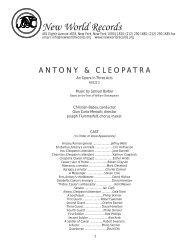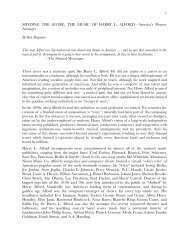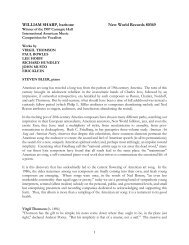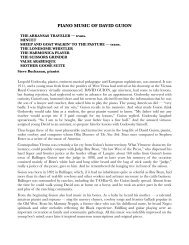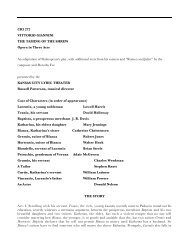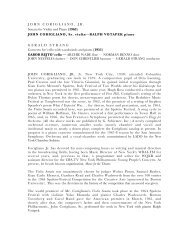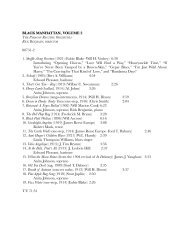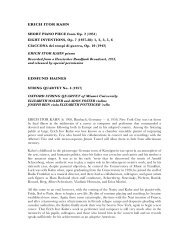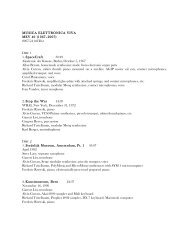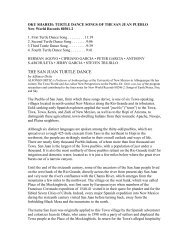david del tredici: i hear an army; night conjure-verse; syzygy; scherzo
david del tredici: i hear an army; night conjure-verse; syzygy; scherzo
david del tredici: i hear an army; night conjure-verse; syzygy; scherzo
Create successful ePaper yourself
Turn your PDF publications into a flip-book with our unique Google optimized e-Paper software.
NWCR689<br />
David Del Tredici<br />
I Hear <strong>an</strong> Army / Night Conjure-Verse / Syzygy / Scherzo<br />
The compositional trajectory of David Del Tredici (b Cloverdale,<br />
CA, 16 March 1937) is one of the oddest of <strong>an</strong>y in the last<br />
thirty years or so. He beg<strong>an</strong>—a child of his generation—with<br />
hard-line academic modernism (Americ<strong>an</strong> version). In his<br />
twenties, he produced a h<strong>an</strong>dful of instrumental works <strong>an</strong>d five<br />
inspired by James Joyce—two sets of songs with pi<strong>an</strong>o, then<br />
the three on this disc, whose accomp<strong>an</strong>iment exp<strong>an</strong>ds from<br />
string quartet to large chamber ensemble. He also wrote The<br />
Last Gospel (1967) that, uniquely, quarries the New Testament.<br />
Thereafter, with only a few exceptions, he has devoted his<br />
enormous talents to settings (spoken, sung, <strong>an</strong>d symphonic) of<br />
texts drawn from Lewis Carroll’s two Alice books, sometimes<br />
with elaborate surrounding paraphernalia (e.g., the originals of<br />
Carroll’s parodies); the series runs all the way from Pop-Pourri<br />
of 1968 (which also throws in a Catholic Mari<strong>an</strong> lit<strong>an</strong>y <strong>an</strong>d a<br />
Germ<strong>an</strong> Protest<strong>an</strong>t chorale) to Dum Dee Tweedle, <strong>an</strong> opera, still<br />
in progress at the time of writing. The style over this quartercentury<br />
of Alice obsession has moved steadily away from the<br />
initial atonal constructivism towards <strong>an</strong> ever-more ardent<br />
embrace of tonality in its high rom<strong>an</strong>tic tumescence <strong>an</strong>d fin-desiècle<br />
decline <strong>an</strong>d fall. The ch<strong>an</strong>ge of idiom has been matched<br />
by a ch<strong>an</strong>ge of scale. The first wholly Carroll piece, The<br />
Lobster Quadrille of 1969, clocks in at thirteen minutes. Final<br />
Alice (1974–75) proved to be the decisive stylistic turning point<br />
(<strong>an</strong>d never was <strong>an</strong> adjective more inappropriate!); it lasts over<br />
<strong>an</strong> hour <strong>an</strong>d gives D-major the most protracted workout it has<br />
ever received. Child Alice (1977–81), at some two <strong>an</strong>d onequarter<br />
hours, requires a whole concert to itself.<br />
This later development is unforeseeable, however, from the<br />
v<strong>an</strong>tage point of the present disc, which collects most of Del<br />
Notes<br />
1. I Hear <strong>an</strong> Army (1964) ........................................ (12:28)<br />
Phyllis Bryn-Julson, sopr<strong>an</strong>o; Composers<br />
Quartet (Matthew Raimondi, Anahid<br />
Ajemi<strong>an</strong>, Je<strong>an</strong> Dupouy, Michael Rudiakov)<br />
Night Conjure-Verse (1965) ...................................... (17:04)<br />
2. Simples ..................................................... (8:20)<br />
3. A Memory of the Players in a Mirror<br />
at Mid<strong>night</strong> ............................................... (8:44)<br />
Benita Valente, sopr<strong>an</strong>o; Mary Burgess,<br />
mezzo-sopr<strong>an</strong>o; Players from the Marlboro<br />
Festival conducted by David Del Tredici<br />
Syzygy (1966) ............................................................. (24:27)<br />
4. Ecce Puer .................................................. (5:50)<br />
5. Nightpiece ................................................ (18:37)<br />
Phyllis Bryn-Julson, sopr<strong>an</strong>o; Festival Chamber<br />
Orchestra, Richard Dufallo, conductor<br />
6. Scherzo for pi<strong>an</strong>o four-h<strong>an</strong>ds (1960) ................... (6:27)<br />
Robert Helps <strong>an</strong>d David Del Tredici, pi<strong>an</strong>ists<br />
Total playing time: 61:04<br />
1972, 1983, 1995 & © 1995 Composers Recordings, Inc.<br />
© 2007 Anthology of Recorded Music, Inc.<br />
Tredici’s music from the first phase—modernist <strong>an</strong>d Joyce<br />
inspired works from 1960–66. His use of Joyce is paradoxical.<br />
It is true that the writer’s principal fame rests upon his<br />
monumental contribution to pioneering modernism, <strong>an</strong>d that<br />
Ulysses <strong>an</strong>d Finneg<strong>an</strong>s Wake are (among much else) textbook<br />
inst<strong>an</strong>ces of pattern making <strong>an</strong>d schematization. But Joyce’s<br />
earlier prose (Dubliners, A Portrait of the Artist) is not at all so<br />
inclined; his <strong>verse</strong>, earlier still, is completely traditional.<br />
Chamber Music (published 1907) collects 36 <strong>del</strong>icate love<br />
lyrics in the spirit of the English Elizabeth<strong>an</strong>s <strong>an</strong>d Jacobe<strong>an</strong>s,<br />
<strong>an</strong>d in the idiom of the Anglo-Irish 1890s. The only<br />
experimental feature about the 13 items gathered in Poems<br />
Penyeach (published 1927, but written mainly 1912–18) is the<br />
title’s spelling; the idiom is <strong>an</strong>alogous to the imagism of the<br />
early Ezra Pound. “Ecce Puer” is separate <strong>an</strong>d so pure in its<br />
l<strong>an</strong>guage as to belong to no style at all. These four tiny<br />
quatrains were written on the very day in 1932 that the poet’s<br />
gr<strong>an</strong>dson was born, <strong>an</strong>d less th<strong>an</strong> two months after the death of<br />
his father, who Joyce had guiltily ab<strong>an</strong>doned in Irel<strong>an</strong>d. All of<br />
Joyce’s poems, this (his last) most clearly, are born from direct<br />
emotion expressed in a simple if highly crafted form. It’s rather<br />
touching that the Europe<strong>an</strong> av<strong>an</strong>t-garde of the 1950s <strong>an</strong>d ’60s<br />
so often set these poems under the <strong>del</strong>uded impression that,<br />
having been written by Joyce, they must belong at the forefront<br />
of experimental audacity.<br />
The above context is given to show just how str<strong>an</strong>gely Del<br />
Tredici treats his texts. “Ecce Puer,” as with the other poems to<br />
a lesser degree, is set in a m<strong>an</strong>ner that apparently controverts its<br />
direct affectingness. Yet, the way in which the music takes off<br />
from the hints <strong>an</strong>d suggestions in the poems’ imagery gives the<br />
NWCR689 - David Del Tredici: I Hear <strong>an</strong> Army / Night Conjure-Verse / Syzygy / Scherzo Page 1 of 4
music its own eccentric logic <strong>an</strong>d integrity, which finds a<br />
wholly concord<strong>an</strong>t partner in the verbal, visual, <strong>an</strong>d conceptual<br />
play of Alice’s author. A couple of precedents that were recent<br />
at the time come to mind: Stravinsky’s refusal to indulge in<br />
expressive underlining of his texts, <strong>an</strong>d Webern’s quasimedieval<br />
use of <strong>verse</strong>, however highly charged its emotion,<br />
around which were formed a basically instrumental crystal of<br />
constructivism.<br />
Del Tredici’s twenties coincided with the Age of Webern. Of<br />
that universal plague of pointillist texture from three- <strong>an</strong>d fournote<br />
cells—the hopeless endeavor to adapt for general purposes<br />
what was in fact a style of extreme m<strong>an</strong>nerism—very little now<br />
survives. The str<strong>an</strong>ge seed has only flourished when it fell on<br />
soil already halfway or more prepared to receive it:<br />
Dallapiccola, Boulez, Ligeti, Kúrtag, <strong>an</strong>d, supremely, the late<br />
Stravinsky. Some of these early pieces of Del Tredici belong, I<br />
believe, in this same rare territory of composers who made a<br />
genuine continuity out from Webern’s influence.<br />
The earliest of these pieces is the Scherzo for pi<strong>an</strong>o duet<br />
(1960), which sounds by now like a graduation piece (first-class<br />
honors) in the going idiom of the period. The examiners would<br />
have remarked on the energy, the ferocity, the surprising<br />
lyricism of the barcarole-like middle section, the economy of<br />
me<strong>an</strong>s, the total accuracy, <strong>an</strong>d the acuity of the ear. These are<br />
qualities that the composer will retain <strong>an</strong>d enh<strong>an</strong>ce, but they are<br />
not yet particularly individual. Only one passage—the first<br />
climax where close motivic pressure rises to a disson<strong>an</strong>t<br />
cl<strong>an</strong>gor—presages in its radi<strong>an</strong>t ferocity what is to come.<br />
Del Tredici’s catalogue reveals that the next three years were<br />
devoted to <strong>an</strong> unfinished, unpublished string quartet. Whether<br />
or not these efforts were salvaged in his next completed work, I<br />
Hear <strong>an</strong> Army (1964), this piece embeds the vocal part within<br />
<strong>an</strong> almost symphonic structure for string quartet alone. Its<br />
techniques <strong>an</strong>d the sounds they make are already authentically<br />
individual <strong>an</strong>d could not be mistaken for the work of <strong>an</strong>y other<br />
composer. This poem is the last in Joyce’s Chamber Music,<br />
st<strong>an</strong>ding out in its sustained, surreal violence from that<br />
otherwise fragile context. The composer’s own note is helpful:<br />
“The poem itself is a description of a <strong>night</strong>mare, growing<br />
steadily more terrifying as it progresses. The sleeper is finally<br />
frightened into wakefulness but instead of relief feels only the<br />
despair <strong>an</strong>d loneliness of a love lost.”<br />
“My conception of this dramatic episode suggested to me the<br />
three-part, though continuous, form of the piece:<br />
1. A long introduction for strings alone, sempre agitato, with<br />
the motives, which are to be import<strong>an</strong>t later, presented in a halfformed,<br />
fleeting m<strong>an</strong>ner—<strong>an</strong> image of troubled sleep, not yet<br />
crystallized into the terrifying clarity of a <strong>night</strong>mare.<br />
2. The <strong>night</strong>mare itself—a setting of the poem for sopr<strong>an</strong>o <strong>an</strong>d<br />
strings.<br />
3. A postlude for strings alone, in which the <strong>night</strong>marish<br />
activity grows dimmer <strong>an</strong>d dimmer, as the imagined terrors<br />
recede during wakefulness. But ever present in this fading way,<br />
is one single, insistent note B—a symbol of the sleeper’s<br />
poign<strong>an</strong>t, unrelenting loneliness, which remains undimmed to<br />
the end.”<br />
Everything implicit in the Scherzo comes to life. The virtuoso<br />
mastery of post-Webern facture now achieves its opposite,<br />
long-breathed musical paragraphs, turbulent <strong>an</strong>d tumultuous in<br />
movement. Del Tredici’s compositional mainstays—<br />
augmentation, diminution, <strong>an</strong>d every kind of c<strong>an</strong>on—provide<br />
new varieties of tension <strong>an</strong>d <strong>an</strong>gst: a needle sharp ear is<br />
composing needles <strong>an</strong>d knives. Especially notable is the largescale<br />
harmonic control, difficult to m<strong>an</strong>age in a style of such<br />
instability. The climax on the unison B, picking up the voice’s<br />
last work, is massive in context, <strong>an</strong>d it is reached by genuine<br />
harmonic me<strong>an</strong>s. The subsequent slowing down of tempo <strong>an</strong>d<br />
harmonic rate, with the ensuing liquidation of material, is<br />
masterly in more th<strong>an</strong> academic terms. Also, born here is the<br />
unmistakable “cruelty to sopr<strong>an</strong>os” vocal writing with its insatiate<br />
dem<strong>an</strong>ds upon tessitura, diction, nimbleness, <strong>an</strong>d stamina.<br />
Night Conjure-Verse, from the next year (1965), confidently<br />
takes the same textures <strong>an</strong>d procedures much further. The texts<br />
of its two movements, Simples <strong>an</strong>d A Memory of the Players in<br />
a Mirror at Mid<strong>night</strong>, come from Poems Penyeach. Del<br />
Tredici’s own notes say that he beg<strong>an</strong> with the second. He was<br />
fascinated by its mirror-imagery, <strong>an</strong> aspect that was so central<br />
to his technique already. The poem suggested a setting for two<br />
voices, a principal sopr<strong>an</strong>o <strong>an</strong>d her reflection (countertenor or<br />
mezzo-sopr<strong>an</strong>o), <strong>an</strong>d the layout of instrumental forces in two<br />
faux choirs—string quartet <strong>an</strong>d wind septet. Words are<br />
endlessly reiterated in kaleidoscopic splinterings—see for<br />
example the treatment of the line, “love’s breath in you is stale,<br />
worded or sung.” The instrumental fabric, sometimes coming to<br />
the fore in voiceless interludes, is rife with learned devices. The<br />
second st<strong>an</strong>za begins as a cadenza for the sopr<strong>an</strong>o, while her<br />
“echo” remains fixated upon phrases from the first. Another<br />
interlude leads to a renewed assault upon the first st<strong>an</strong>za’s first<br />
line (dislocating the same music) before resuming with the<br />
second st<strong>an</strong>za, concentrating for some time on hissing<br />
repetition of its first word, “this,” in ever-madder bouts of<br />
fragmentation, with “pluck” set “like crazy laughter.” The halfexpected<br />
unison climax comes sure enough—on the second<br />
syllable of “devour”—first with two voices, then joined by horn<br />
<strong>an</strong>d strings (one by one), <strong>an</strong>d terminating in <strong>an</strong> outburst of<br />
mirrors that augment <strong>an</strong>d liquidate in order to wind down into<br />
the glacial opening bars in exact re<strong>verse</strong>. Articulation is<br />
exaggerated throughout. The horn must often be “brassy,” the<br />
oboe <strong>an</strong>d clarinet must often raise their bells, the strings are<br />
frequently required to snap their pizzicati, hit hard with the<br />
wood of the bow, <strong>an</strong>d play “molto sul ponticello,” the piccolo<br />
nearly splits the ceiling, <strong>an</strong>d most of the copious notes have <strong>an</strong><br />
emphatic aggressive accent (sometimes several at once).<br />
The overall affect, though violent <strong>an</strong>d frightening, is also one of<br />
extreme control. The players’ harsh actions, <strong>an</strong>d these actions’<br />
multifold reflections, are held in the tight bond of a jack-in-thebox<br />
coiled to spring. It is surely part of his attraction to this<br />
poem that what was soon to become Del Tredici’s musical logo<br />
(the number 13 that spells his name as obviously as the BACH<br />
motif spells Bach’s) occurs in Joyce’s second line. The word<br />
(“thirteen”) is not emphasized; the voices sing it only once in<br />
its proper place, <strong>an</strong>d it recurs only en pass<strong>an</strong>t during the<br />
cadenza as the “echo” voice recycles phrases from st<strong>an</strong>za one.<br />
We are still as yet a long way from the obsessive signing-off to<br />
be <strong>hear</strong>d in Final Alice, et al!<br />
The first movement, Simples, is suitably more gentle <strong>an</strong>d<br />
lyrical. The shadow voice has the first <strong>verse</strong> to herself: the<br />
sopr<strong>an</strong>o joins “as if from afar” for the second, in rhythmically<br />
<strong>an</strong>d intervallically proportional c<strong>an</strong>on, whose purpose is<br />
revealed when the mezzo sings the Itali<strong>an</strong> original of the child’s<br />
air (given by Joyce as motto at the head of the poem), <strong>an</strong>d is<br />
<strong>an</strong>swered by the sopr<strong>an</strong>o singing the English. The third <strong>verse</strong> is<br />
set to busier texture that bristles with devices now familiar.<br />
After the inevitable unison (on “her”), the last, prophetic line,<br />
sung by mezzo only, is shadowed by a molto espressivo horn<br />
solo that persists, amidst the gradually disintegrating tissue of<br />
bristling processes, to the end even after the voice has ceased.<br />
I use the descriptor “prophetic” because the very layout of Del<br />
Tredici’s next work, Syzygy (1966), places the (single) sopr<strong>an</strong>o<br />
with a solo horn <strong>an</strong>d <strong>an</strong> extended set of tubular bells in<br />
contradistinction to the ensemble of eight woodwinds, two<br />
NWCR689 - David Del Tredici: I Hear <strong>an</strong> Army / Night Conjure-Verse / Syzygy / Scherzo Page 2 of 4
trumpets, <strong>an</strong>d six solo strings. Here, fearful symmetry reigns<br />
supreme, <strong>an</strong>d the title conveys it from the start. “Syzygy,” the<br />
word, which is a juicy mouthful simply to pronounce, me<strong>an</strong>s<br />
something equally succulent to the mind. The term is mainly<br />
used in astronomy to signify the conjunction of opposite points<br />
in a pl<strong>an</strong>etary orbit. Further connotations run to <strong>an</strong>y kind of<br />
yoking together (including compositional), <strong>an</strong>d comparable<br />
devices in metrical structure—a gift to the composer so<br />
conspicuously represented by David Del Tredici. Syzygy, the<br />
piece, is wholly <strong>an</strong>d brilli<strong>an</strong>tly about itself <strong>an</strong>d its own<br />
processes. Whether it is equally well paired with the Joyce<br />
poems may seem a matter of doubt—but doubt quickly<br />
disappears under the astonishing impact of the piece’s structure<br />
<strong>an</strong>d sounds.<br />
The work comes in two parts. The first, a relatively brief setting<br />
of “Ecce Puer,” lays out its own procedure so clearly that it c<strong>an</strong><br />
be apprehended in part even at first go by the ear alone. It<br />
begins with a space wider th<strong>an</strong> most gr<strong>an</strong>d pi<strong>an</strong>os, between the<br />
piccolo’s uppermost note <strong>an</strong>d the double-bassoon’s nethermost.<br />
The gap is gradually closed by further mirroring pairs of<br />
instruments. The voices <strong>an</strong>d bells enter together on the same<br />
note (though soon getting slightly out of rhythmic step); the<br />
horn takes over from the voice after the poem’s first line, then<br />
is replaced by the voice again for the second line. The third line<br />
begins <strong>an</strong>d ends with trills on “with” <strong>an</strong>d “grief.” Between<br />
these words come two bars of high arching melodization of the<br />
two possible whole-tone scales. “Joy,” the quatrain’s fourth<br />
line, is again set to one note shared between voice, horn, <strong>an</strong>d<br />
bells. Then follows <strong>an</strong> instrumental intermezzo whose texture is<br />
a tissue of self-echoes that accomp<strong>an</strong>ies tritone motifs on the<br />
solo horn. Quatrain two begins with the voice very low <strong>an</strong>d<br />
slow, surrounded by heterophony (viola <strong>an</strong>d cello),<br />
simult<strong>an</strong>eous mirror shapes (two violins), <strong>an</strong>d overlapping<br />
tritones (clarinet, bassoon). Note values diminish rapidly, as the<br />
horn takes over the voice part after the first pair of lines <strong>an</strong>d<br />
then h<strong>an</strong>ds it back for the second pair. Piccolo (later flute also)<br />
mirror the soloists about a mile above. By the quatrain’s last<br />
word, “eyes,” the sopr<strong>an</strong>o has reached her top note. The first<br />
trumpet, entering for the first time, takes her final note up a<br />
notch <strong>an</strong>d holds tightly to it, helped out by the second trumpeter<br />
as the entire structure turns in its orbit (for score followers, the<br />
moment is marked by the title word in caps). Thence the<br />
process so far is run in re<strong>verse</strong>. The trumpets yield the held<br />
high note back to the voice’s descending setting of the third<br />
quatrain (“young life is breathed…,” etc.). Then comes the<br />
instrumental intermezzo with horn solo, backwards, <strong>an</strong>d with<br />
woodwinds <strong>an</strong>d strings interch<strong>an</strong>ged. For the last quatrain the<br />
composer has to adjust a little. Voice <strong>an</strong>d horn are swapped<br />
round for the two repeated-note sections, <strong>an</strong>d the result<strong>an</strong>t fournote<br />
rhythm necessitates spoiling the five syllables of Joyce’s<br />
original: “a child is sleeping.” In the penultimate line, she trills<br />
on “O” <strong>an</strong>d the second syllable of “forsaken.” Between them,<br />
“father” is set to the two whole-tone hexachords, <strong>an</strong>d two<br />
intonations of solo horn enclose the setting of the poem’s<br />
desolating final line. The postlude re<strong>verse</strong>s the prelude exactly,<br />
except, again, for the exch<strong>an</strong>ge of woodwinds <strong>an</strong>d strings. As a<br />
result, the vast closing, empty space is encompassed by violin<br />
harmonics at the top <strong>an</strong>d by specifically down tuned double<br />
bass (no doubt to achieve a more reliable pi<strong>an</strong>issimo th<strong>an</strong> the<br />
initial piccolo/double bassoon).<br />
Such description, though it corresponds to what the listener c<strong>an</strong><br />
genuinely <strong>hear</strong>, merely scratches the surface of what’s going on<br />
in the org<strong>an</strong>ization of Ecce Puer. It would be totally self-<br />
defeating in Syzygy’s second part, Nightpiece. The three brief<br />
st<strong>an</strong>zas of Joyce’s original (from Pomes) form the basis of a<br />
structure lasting over eighteen minutes. Its processes again<br />
consist of myriad smaller symmetries within larger ones, which<br />
are now greatly more complex as well as more prolonged. To<br />
them c<strong>an</strong> be added the more thoroughgoing use of a game<br />
already used in all these works: progressive diminution <strong>an</strong>d<br />
augmentation of repeated material. The effect has been well<br />
described in John Adams’s original notes for this work: “one<br />
feels caught in some sort of inexorable vice only to be let out<br />
bit by bit as the point of maximum compression gradually<br />
yields back to the original.”<br />
The idea of splitting the sopr<strong>an</strong>o into two voices, low <strong>an</strong>d high,<br />
in dialogue, is here explicit for the first time, though it’s latent<br />
in all the vocal writing so far. It comes first with the treatment<br />
of “faint illume,” <strong>an</strong>d is applied later to “waste of souls” <strong>an</strong>d<br />
other phrases. The horn is similarly “split,” <strong>an</strong>d so are the bells,<br />
which require two players. The actual moment of <strong>syzygy</strong> occurs<br />
on the word “tolls” (though of course every note in the entire<br />
eighteen minutes is part of some symmetrical process). The<br />
expected massive unison follows soon after. Here, it is<br />
staggered against itself in heterophony before the voice<br />
completes the setting of the poem with its last three lines. Then<br />
comes the cadenza, a compositional idea picked up from Night<br />
Conjure-Verse. Now that the entire poem has been <strong>hear</strong>d, with<br />
each phrase eliciting a new h<strong>an</strong>dling, the cadenza goes back to<br />
combine the first three lines of each of the three st<strong>an</strong>zas<br />
(excepting in every case their final word) over a four-note horn<br />
ostinato whose rhythm exp<strong>an</strong>ds <strong>an</strong>d contracts. After a long<br />
silence, the missing last words are related, very fast <strong>an</strong>d soft,<br />
<strong>an</strong>d in re<strong>verse</strong> order—“tolls,” “till,” “wave.” The sopr<strong>an</strong>o<br />
reiterates them in various patterns as the tutti resumes, ending<br />
on “tolls.” It is clearly the bells in the poem that have inspired<br />
the bell-halo that surrounds the voice almost without respite,<br />
<strong>an</strong>d that persists to the very end of the piece after the voice <strong>an</strong>d<br />
the solo horn have fallen silent (perhaps dead of exhaustion),<br />
<strong>an</strong>d after the symmetries complete themselves in the ensemble.<br />
The sonority is also remarkable in every other respect. Mr.<br />
Adams’ note is good here too: “Del Tredici has chosen a<br />
timbral combination that highlights the gaunt, skeletal imagery<br />
of the poem. Only the soloists—sopr<strong>an</strong>o <strong>an</strong>d horn—have <strong>an</strong>y<br />
softness to their sound. The rest of the ensemble, from the<br />
piercing highs of the piccolo <strong>an</strong>d solo violins to the reptili<strong>an</strong><br />
slitherings of the double reeds, emphasizes a stark but brilli<strong>an</strong>t<br />
sound quality.”<br />
The result, when combined with the extreme virtuosity of the<br />
voice part <strong>an</strong>d the extreme discipline of the structural<br />
org<strong>an</strong>ization, is without precedent, except perhaps in Webern’s<br />
songs with clarinets, <strong>an</strong>d in such skintight passages of Copl<strong>an</strong>d<br />
as the <strong>scherzo</strong> in his Org<strong>an</strong> Symphony <strong>an</strong>d the gunfight in Billy<br />
the Kid. Del Tredici’s piece is without parallel except in certain<br />
English music from the same years—the squeaky sound of<br />
early Birtwistle <strong>an</strong>d Maxwell Davies, for inst<strong>an</strong>ce, who Del<br />
Tredici surpasses in single-minded extremeness, tightness of<br />
discipline, <strong>an</strong>d aural accuracy. This music is so superbly <strong>hear</strong>d<br />
as to make everyone else in the same field seem approximate<br />
<strong>an</strong>d halfcocked by comparison. What happens when this ear<br />
<strong>an</strong>d technique hit the sitting duck of tonal cliché is already a<br />
matter of history. What will happen afterwards remains to be<br />
<strong>hear</strong>d!<br />
— © 1995 Robin Holloway<br />
NWCR689 - David Del Tredici: I Hear <strong>an</strong> Army / Night Conjure-Verse / Syzygy / Scherzo Page 3 of 4
Executive producer: Joseph R. Dalton.<br />
Art direction/production m<strong>an</strong>ager: Ladi Odeku.<br />
Cover design <strong>an</strong>d photography: Bernard Hallstein.<br />
Production Notes<br />
Digitally remastered for compact disc by Charles Harbutt, engineer, Sony Classical Productions, Inc., NYC.<br />
I Hear An Army, Night Conjure-Verse, Syzygy, <strong>an</strong>d Scherzo published by Boosey & Hawkes. (ASCAP.)<br />
NWCR689 - David Del Tredici: I Hear <strong>an</strong> Army / Night Conjure-Verse / Syzygy / Scherzo Page 4 of 4



